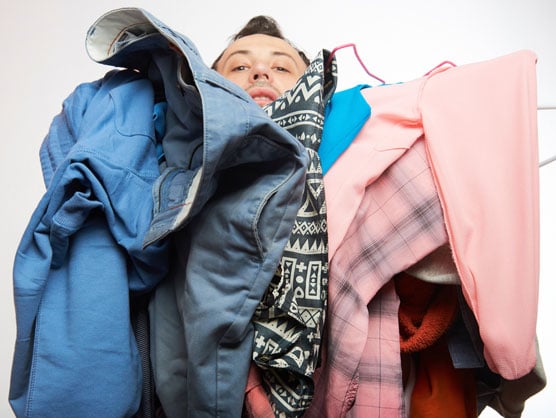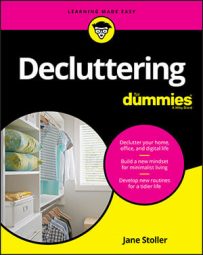 ©By PixieMe/Shutterstock.com
©By PixieMe/Shutterstock.comThe negative effects of clutter
Go back to a time when you were surrounded by clutter and remember how it made you feel. It may have been a cluttered desk or a stuffed attic, or maybe your mind was full of so many tasks you didn’t know where to start. You don’t need a psychology degree to understand that when you think about clutter, you get a bit stressed, or in medical terms, your cortisol levels rise.
- Clutter can and will make you feel inadequate. When you have too much stuff, it can inhibit your ability to live the life you desire. Having a cluttered environment can result in feelings of low self-worth and even depression in some cases.
- Clutter can hinder your focus. Clutter can compete for space in your brain, therefore keeping you from giving your full attention to what is important.
- Clutter can negatively affect your behavior and the behavior of those around you. We gain energy from our surroundings; waking up to an efficient home with things you use daily versus waking up to a big pile of junk makes a difference. Clutter not only creates a chaotic environment, which impacts your behavior and attitude toward yourself and others, but it can also impact those around you.
Breaking free from clutter forever
Decluttering involves being brutally honest with yourself and creating a complete decluttering mindset. Relating your stuff to bigger picture topics including finances, consumer habits, and also breaking the cycle of binge-shopping and purging can help you rid your cluttered tendencies and start living better — today.
- Declutter, declutter, and then declutter again. Decide what to keep and swiftly get rid of the rest. If you make this a routine, you’ll never have excess clutter again. Be consistent!
- Realize you are not what you own. Getting rid of items you no longer use or that are no longer practical can help free up mental and physical space. Once you experience the increased productivity that comes from living in a clutter-free space, you’ll realize that your items don’t give you the happiness or meaning you once thought.
- Don’t buy items without extensive questioning. “Do I really need this? Will this add value to my life? Is this item worth the space I am going to give it in my home?” These are all good questions to ask before purchasing anything new.
- Eliminate distractions. If you can get rid of excess stuff, you can have more freedom to dive into your life goals, deepen your relationships (with people, not stuff!) and create the life you want.
Dealing with clutter efficiently
Regardless of how much clutter you have, you want to be as efficient as possible when dealing with it. You want to feel in control of the process as much as the result.
- Start with one area. This should be your highest priority or the area that causes you the most stress or is the least efficient area of your home and/or workspace.
- Give yourself a timeline. As with any goal, you need to have an attainable date for completion so you don’t get frustrated and give up.
- Plan time. In addition to completion dates, you need to plan the time you will actually declutter. Hint: The shorter the time span, the more you increase your chances of tackling the project.
- Use time cubes to keep you on track. Today’s culture is fast-paced and distracting. Use a timer when decluttering to keep to your planned time and increase your efficiency.
- Get rid of clutter. Do this immediately. The longer your clutter stays in your house (i.e. in a garbage bag by the door), the more likely it is to work its way back into its original spot and never leave. Arrange a pick-up from a local charity if you’re worried you won’t have time to deal with it yourself.
How to differentiate practical versus emotional items
Often the biggest challenge with decluttering and the reason we procrastinate or can’t get rid of things is our emotional attachment. It is very important to have a set of criteria for decluttering to help you with the process. Determining what is practical versus emotional is a personal decision, but I want to inspire you to be honest with yourself. Try asking yourself these questions:
- Is it practical?
- Do you use this item on a regular basis?
- Does it provide value to your life?
- Does it provide value to your home?
- Can someone else use it?
- Is it emotional?
- Are you keeping this because of a memory?
- Do you have similar items attached to this memory?
- Is this item a gift from someone special but you don’t use it/like it?
- Would your friends or family see the value in this item?
Digital decluttering basics
Consistent digital decluttering can improve your productivity and the quality of your work. I am a firm believer in regularly decluttering your digital life, and I know that instead of doing this task once in a while or when you get that dreaded note on your computer stating that you have no more storage space, you should be digitally decluttering regularly.
- Set up your digital decluttering strategy before it is too late.
- Imagine the reduced stress and increased productivity once you’ve digitally decluttered.
- Find everything quickly in your digital world by getting rid of excess photos, emails, newsletter subscriptions, files, and so on.
- Don’t get overwhelmed by spam; deal with it immediately.
Closet organizing quick tips
During your closet inventory process, I recommend labeling a few boxes: “Donate,” “Repurpose,” “Tailor,” “Sell,” and “Toss.” Then, you can place your items in the appropriate box as you go through them and accomplish multiple steps at once.
- Donate: Donating should be at the heart of your decluttering mindset. Being able to donate your items to benefit others not only helps your closet stay clutter-free but also helps you improve other people’s lives.
- Repurpose: An often-forgotten part of decluttering, a multitude of closet items can be repurposed.
- Tailor: Tailoring can mean so much more than getting your jeans hemmed. This is a great option to make your clothes last longer and lessen your consumption of new items.
- Sell: This approach is a great way for fashionistas to keep wearing the top trends and be able to frequently switch styles.
- Toss: At some point, closet items will no longer be usable.
Kitchen and home decluttering strategies
Your kitchen and all spaces in your home should work for you. You may have to make some tough decisions on some items that don’t necessarily look pretty but are highly functional.
- Don’t have endless multiples. This causes wasted space and leads to excess clutter.
- Choose function over aesthetic. It’s easy to get carried away making your kitchen or any space look really pretty. Focus again on only what you use.
- Evaluate your storage. Is your storage space used in the most efficient way it can be?
- Pay attention to placement. Position your items so that you know what you have. For example, position your food to waste less by placing it with its expiry date in eyesight.
- Be practical. Think before you act. Be practical with where you put your items.
Photo decluttering
It’s time to stop procrastinating and deal with your photos. Start today and create a system to declutter your current and future photos.
- Get rid of duplicates ASAP. There is no point in hanging onto extras.
- Cull the bad ones. Blurry, out-of-focus, and bad quality photos need to go.
- Create a system. Organize by year, person, or event and dedicate weekly or monthly time to keep on top of your photo decluttering.
- Treat fragile ones with care. For print photos, older images may be in bad condition. Take these to a professional for restoration before it is too late.
- Curate and display rather than store. Photos can bring you so much joy. To reduce excess photo storage, display photos around your home.
- View and remember the good times. Seeing images in your home that spark good memories can help you care more for your photos, increasing your chances of decluttering consistently.
- Let go of the past. Get rid of those photos of your ex, or anything else you want to move on from!

